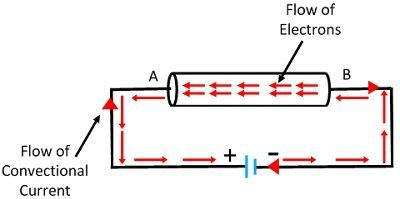Definition: The electric current flow of electric charge
Electric current is characterized as the pace of stream of negative charges of the conduit. At the end of the day, the nonstop progression of electrons in an electric circuit is called an electric current. The leading material comprises countless free electrons that move from one iota to the next at irregular.
परिभाषा: विद्युत प्रवाह को नाली के नकारात्मक आवेशों की धारा की गति के रूप में जाना जाता है। दिन के अंत में, एक विद्युत परिपथ में इलेक्ट्रॉनों की नॉनस्टॉप प्रगति को विद्युत प्रवाह कहा जाता है। अग्रणी सामग्री में अनगिनत मुक्त इलेक्ट्रॉन होते हैं जो अनियमित रूप से एक iota से अगले में जाते हैं।
एक विद्युत प्रवाह एक बिंदु या क्षेत्र के पिछले विद्युत आवेश के प्रवाह की दर है। एक विद्युत प्रवाह कहा जाता है जब एक क्षेत्र के माध्यम से विद्युत आवेश का शुद्ध प्रवाह होता है। विद्युत परिपथों में यह आवेश प्रायः इलेक्ट्रॉनों द्वारा एक तार से चलते हुए किया जाता है।
The electric current flow of electric charge
Watch Video of Electric Current >>Click Here <<
Learn More about Parts Of A Flower And Its Functions In Hindi And English | एक फूल और उसके कार्य के भाग MoreMore
Unit of Current | विद्युत की इकाई
Since the charge is estimated in coulombs and time in a moment or two, so the unit of electric current is coulomb/Sec (C/s) or amperes (A). The amperes is the SI unit of the conductor. The I is the emblematic portrayal of the current.
चूँकि आवेश का अनुमान युग्मनों और समय में एक या दो क्षण में होता है, इसलिए विद्युत धारा की इकाई युग्मन / सेक (C / s) या एम्पीयर (A) होती है। एम्पीयर कंडक्टर की एसआई इकाई है। I वर्तमान का प्रतीक चित्रण है।
Q=1 Coloumb; t=1 second; then
I=1A
In this way, a wire is said to convey a current of one ampere when the charge moves through it at the pace of one coulomb for every second.इस तरह, एक तार को एक एम्पीयर की धारा को संप्रेषित करने के लिए कहा जाता है, जब चार्ज प्रत्येक सेकंड के लिए एक युग्मन की गति से इसके माध्यम से आगे बढ़ता है।
At the point when an electrical potential contrast is applied over the metallic wire, the inexactly appended free electrons begin moving towards the positive terminal of the cell that appeared in the figure beneath. This ceaseless progression of electrons comprises the electrical current. The progression of currents in the wire is from the negative terminal of the cell to the positive terminal through the outside circuit.
इस बिंदु पर जब धातु के तार के ऊपर एक विद्युत संभावित विपरीत लागू किया जाता है, तो सटीक रूप से संलग्न मुक्त इलेक्ट्रॉनों को नीचे की आकृति में दिखाई देने वाले सेल के सकारात्मक टर्मिनल की ओर बढ़ना शुरू होता है। इलेक्ट्रॉनों की इस निरंतर प्रगति में विद्युत प्रवाह शामिल होता है। तार में धाराओं की प्रगति सेल के नकारात्मक टर्मिनल से बाहरी सर्किट के माध्यम से सकारात्मक टर्मिनल तक होती है।
Top Tips Of Study smarter | Ways To Study SMART & Study EFFECTIVELY | Scientific Ways to Learn Faster >>Click Here<<
इलेक्ट्रॉन परिकल्पना के अनुसार, जब ट्रांसमीटर पर संभावित अंतर लागू किया जाता है तो कुछ समस्या सर्किट से गुजरती है जो विद्युत प्रवाह को स्थापित करती है। यह देखा गया था कि यह मुद्दा संभावित क्षमता को नीचे लाने के लिए उच्च क्षमता से प्रवाहित होता है, उदाहरण के लिए सकारात्मक टर्मिनल सेल के नकारात्मक टर्मिनल से बाहर के सर्किट के माध्यम से।
विद्युत-धारा-1-धारा की धारा का यह शो इतना स्थाई रूप से बसा हुआ है कि यह अभी भी उपयोग में है। इसके अलावा, धारा की धारा का पारंपरिक पाठ्यक्रम कोशिका के सकारात्मक टर्मिनल से बाहरी के माध्यम से कोशिका के नकारात्मक टर्मिनल तक है सर्किट। कंडक्टर के किसी भी क्षेत्र में धारा की धारा की महानता इलेक्ट्रॉनों की धारा की गति है उदाहरण के लिए चार्ज हर पल स्ट्रीमिंग।
Electric Current & Power | विद्युत प्रवाह | Learn about the electric Current >>Click Here<<
Solar System | Learn more about the solar system>>Click Here<<
Magnetic Domain | Magnet, its Properties and Magnetic Domains | Magnetic Domain In Hindi And English
>>Click Here<<
electric voltage meaning | meaning of electric circuit | meaning of electric charge | electric current meaning in Hindi | define the term induced electric current | what is the meaning of potential | difference | electric current | Formula & Definition | Britannica | Electric Current Definition, Formula, Unit, and Circuit Diagram | what is electric current | electric current in English | electric current in Hindi meaning | what is the voltage in Hindi | electric current formula | types of electric current in Hindi | direction of electric current | what is electricity in Hindi | What is meant by electric current? | What is the electric current formula? | What is called current? | What is electric current and electricity? | electric current formula | electric current unit | electric current examples | electric current symbol | direction of electric current | what is electric current short answer | electric charge | types of current







.JPG)

0 Comments